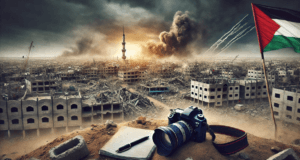Palestinian Journalists Targeted by Israel: 5 Powerful Stories of Courage Amid Destruction
On March 24, 2025, Palestinian journalist Hossam Shabat was killed in an Israeli airstrike, just hours after reporting the death of fellow journalist Mohammed Mansour. Hossam, who worked for Al Jazeera and Drop Site News, had received death threats before his tragic end and had written a chilling message warning that his death would likely be targeted. This marks the continued pattern of Israeli forces deliberately targeting journalists in Gaza, where over 200 media workers have been killed since the conflict began in October 2023.
Hossam’s final article vividly described the devastation caused by ongoing bombings in Gaza. Palestinian journalists like Hossam and Abubaker Abed risk their lives to report on the horrors of war, often enduring extreme conditions. The deaths of these reporters serve as a stark reminder of the toll the conflict has taken on Gaza’s people, with over 50,000 killed since October 2023.

Palestinian Journalists Targeted by Israel: 5 Powerful Stories of Courage Amid Destruction
On March 24, 2025, 23-year-old Palestinian journalist Hossam Shabat was killed in an Israeli airstrike while reporting for Al Jazeera and Drop Site News. Just hours before his death, he shared a post on Instagram announcing the killing of fellow journalist Mohammed Mansour in a similar attack. Both men are among more than 200 journalists and media workers who have lost their lives in Gaza since Israel’s military campaign began in October 2023.
Hossam left behind a haunting message: “If you’re reading this, it means I have been killed—most likely targeted—by the Israeli occupation forces.” The young reporter had repeatedly faced death threats prior to his killing. His colleague, Sharif Abdel Kouddous, an editor at Drop Site News, accused the Israeli military of deliberately targeting Hossam, despite his clear identification as a journalist wearing a press vest. Israeli authorities had falsely labeled him a “terrorist,” a tactic often used to justify attacks on media workers.
Hossam’s death reflects a brutal pattern of violence against Palestinian journalists. Many, like him, have reportedly been added to Israeli military “hit lists,” accused of ties to militant groups without evidence. These journalists work under relentless bombardment, risking their lives to document Israel’s assault on Gaza and share stories of civilian suffering with the world.
In his final article, Hossam described the terror gripping Gaza as bombs rained down daily. He wrote about entire neighborhoods reduced to rubble, children buried under debris, and families scrambling to survive without food, water, or medical care. For months, he had chronicled these horrors, often choosing to stay in evacuation zones to remain close to the people he reported on. “I could leave,” he once said, “but how do I abandon those who can’t escape?”
Other journalists continue to face similar dangers. Abubaker Abed, a 25-year-old reporter, described surviving on one meal a day while dodging airstrikes. “We’re not just reporting the news—we’re living it,” he said. “Every day could be our last.” Like Hossam, Abed called for global intervention to end the violence and lift Israel’s 17-year blockade on Gaza, which has pushed the population to the brink of famine.
The killings of journalists like Hossam and Mohammed are part of a broader humanitarian catastrophe. Over 50,000 Palestinians—mostly women and children—have been killed in Gaza since October 2023. Yet, much of the world remains unaware of the scale of the crisis. Israel’s restrictions on international media access, coupled with its systematic targeting of local journalists, have obscured the truth. Reporters Without Borders has called Gaza a “graveyard for journalists,” accusing Israel of using violence to silence critical voices.
Hossam’s story underscores the courage of Palestinian journalists who continue working amid unimaginable risks. Their reporting—often the only window into Gaza’s reality—reveals a war marked by indiscriminate attacks on homes, hospitals, and refugee camps. As Hossam wrote in his final piece, “This isn’t just a war on Hamas. It’s a war on an entire people.”
Global press freedom groups and human rights organizations have condemned Israel’s actions, demanding accountability for the killings. However, with major powers like the U.S. continuing to supply military aid to Israel, calls for justice have gone unanswered. Meanwhile, Palestinians in Gaza urge the world to look beyond headlines and recognize their struggle for survival.
Hossam’s legacy lives on in the work of journalists still documenting the siege. “We do this so history cannot ignore what happened here,” said Abed. “Even if we die, our stories must survive.” For those in Gaza, the message is clear: Silence their voices, and you erase their truth.
You must be logged in to post a comment.